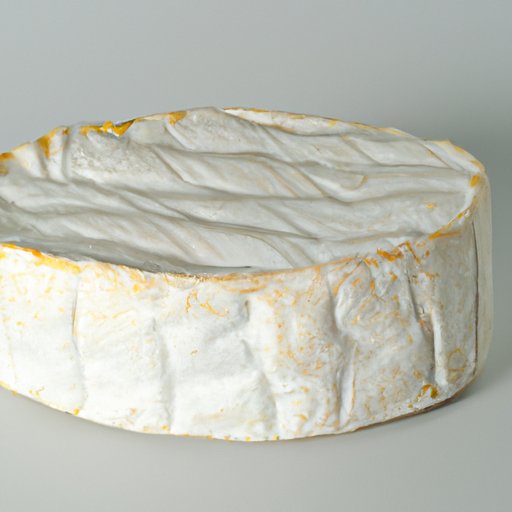
Introduction
Brie cheese has long been a beloved cheese, with its soft and rich texture and mild, tangy flavor. However, there is a lot of debate about one particular aspect of this cheese – the rind. Many people wonder whether it is safe and/or desirable to eat the rind of brie cheese. This article aims to demystify the controversy surrounding brie rind and provide you with the information you need to decide for yourself whether or not to eat it.
Breaking Bread: The Truth About Brie Rind
Brie rind is the white, edible layer that forms on the outer surface of a piece of brie cheese. This rind is created by a specific culture of mold, which is allowed to grow on the surface of the cheese during the aging process. As the cheese ages, the mold breaks down the surface of the cheese, creating the creamy, soft texture that is characteristic of brie cheese.
Brie rind has a mild, slightly nutty flavor and a slightly chewy texture. Some people describe the taste as earthy or musty, which can be an acquired taste for some. However, brie rind is completely safe to eat and is not made of harmful mold or bacteria.
Fromage 101: To Eat or Not to Eat Brie Rind
There are several potential health benefits to eating brie rind, as it contains beneficial probiotics that can promote healthy digestion and immune function. However, there are also some potential risks associated with consuming the rind, such as high levels of sodium or excessive fat.
Additionally, the decision to eat brie rind often comes down to cultural and regional traditions. In France, for example, it is common to eat the rind as part of the cheese. In other cultures, such as the United States, the rind is often discarded due to lack of familiarity or misunderstanding of its edibility.
According to some food experts and nutritionists, there is no clear consensus on whether or not to eat brie rind. Some argue that the texture and flavor of the rind are an integral part of the cheese-eating experience, while others believe that the rind can be too musty or overpowering for some palates.
The Great Brie Rind Debate: What You Need to Know
The debate around brie rind centers largely around arguments for and against consuming it as part of the cheese. Some people believe that the rind adds complexity and depth to the flavor of the cheese, while others find it unpleasant and unnecessary.
There are also prevalent misconceptions about the safety of brie rind, with some people believing that the rind is composed of mold that is harmful to eat. However, as mentioned earlier, the rind of brie cheese is created by a specific type of mold that is completely safe and edible.
Brie and Beyond: Exploring the Edibility of Rind
Brie is just one example of a cheese with an edible rind. There are many other types of cheese that feature edible rinds, such as Camembert, Saint-Nectaire, and Bonde d’Antan. Each type of rind has a unique texture and flavor that can add interest and complexity to the cheese.
In addition to being consumed as part of the cheese, rinds can also be used in cooking and recipes. For example, brie rind can be added to soups or stews to add a rich, creamy texture and flavor.
Cheesemonger’s Guide: Understanding Brie Rind
For those who are still unsure about whether or not to eat brie rind, it can be helpful to consult a cheesemonger. Cheesemongers are experts in all things cheese and can provide valuable information about different types of cheese and their rinds.
A cheesemonger may recommend different types of brie cheeses based on personal taste preferences, as well as provide guidance on storage and serving techniques. They can also provide advice on cheese pairing, including which types of cheese rinds complement different types of food and drink.
The Rind Factor: Why You Should or Shouldn’t Eat Brie Rind
Ultimately, the decision of whether or not to eat brie rind comes down to personal preference. While there are arguments for and against consuming the rind, there is no clear-cut right or wrong answer. Some people may find the rind unpleasant or overpowering, while others may enjoy the added flavor and texture it provides.
Regardless of your personal preferences, it is important to make informed choices about the food you consume. By understanding the facts about brie rind and considering your personal taste preferences, you can make the decision that is best for you.
Conclusion
The controversy surrounding brie rind may seem trivial, but it speaks to a larger issue of educating ourselves about the food we eat. By taking the time to understand the history, cultural traditions, and unique characteristics of different types of food, we can make more informed choices and fully appreciate the flavors and textures that make each type of food so special.




